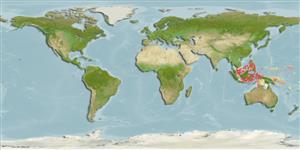>
Gobiiformes (Gobies) >
Gobiidae (Gobies) > Gobiinae
Etymology: Trimma: Greek, trimma, -atos = something crushed (Ref. 45335); gigantum: Named for the Greek word 'gigas, gigantas' meaning giant, referring to its extremely large size (informally referred to as Trimma RW sp 90, undescribed species, in litt.)..
More on authors: Winterbottom & Zur.
Environment: milieu / climate zone / depth range / distribution range
Ecologia
marino associati a barriera corallina; distribuzione batimetrica 57 - 73 m (Ref. 59339). Tropical
Distribuzione
Stati | Aree FAO | Ecosystems | Presenze | Point map | Introduzioni | Faunafri
Western Pacific: Palau to Indonesia.
Size / Peso / Age
Maturity: Lm ? range ? - ? cm
Max length : 3.0 cm SL maschio/sesso non determinato; (Ref. 59339); 2.8 cm SL (female)
Short description
Morfologia | Morfometria
Spine dorsali (totale): 7; Raggi dorsali molli (totale): 8-9; Spine anali 1; Raggi anali molli: 7 - 9. This species is a member of the T. tevegae species complex (sensu Winterbottom 2005) with a broad interorbital space and a greatly expanded first haemal arch. It is further characterized by 15-18 predorsal scales; the second and third dorsal spines elongate; a fleshy, longitudinal ridge in the interorbital midline; absence of postorbital trenches; scales covering the cheek and opercle; the fifth pelvic fin ray usually branched dichotomously once; a pattern of six dark saddles across the dorsum on a pale yellow background; and, large adult size (to about 30 mm SL) (Ref. 59339).
Inhabits outer reef slopes in caves and crevices in 57-73 m (Ref. 90102).
Life cycle and mating behavior
Maturità | Riproduzione | Deposizione | Uova | Fecundity | Larve
Winterbottom, R. and M. Zur, 2007. Three new species of genus Trimma from Palau (Percomorpha: Gobioidei). aqua, Int. J. Ichthyol. 13(1):13-24. (Ref. 59339)
IUCN Red List Status (Ref. 130435)
Threat to humans
Harmless
Human uses
Informazioni ulteriori
Nomi ComuniSinonimiMetabolismoPredatoriEcotossicologiaRiproduzioneMaturitàDeposizioneSpawning aggregationFecundityUovaEgg development
Age/SizeAccrescimentoLength-weightLength-lengthLength-frequenciesMorfometriaMorfologiaLarveDinamica popolazioni larvaliReclutamentoAbbondanzaBRUVS
BibliografiaAcquacolturaProfilo di acquacolturaVarietàGeneticaElectrophoresesEreditarietàMalattieElaborazioneNutrientsMass conversion
CollaboratoriImmaginiStamps, Coins Misc.SuoniCiguateraVelocitàModalità di nuotoArea branchialeOtolithsCervelliVista
Strumenti
Special reports
Download XML
Fonti Internet
Estimates based on models
Preferred temperature (Ref.
123201): 27.2 - 28.2, mean 27.8 °C (based on 7 cells).
Phylogenetic diversity index (Ref.
82804): PD
50 = 0.5000 [Uniqueness, from 0.5 = low to 2.0 = high].
Bayesian length-weight: a=0.01023 (0.00477 - 0.02194), b=3.02 (2.84 - 3.20), in cm total length, based on LWR estimates for this (Sub)family-body shape (Ref.
93245).
Resilienza (Ref.
120179): Alto, tempo minimo di raddoppiamento della popolazione meno di 15 mesi (Preliminary K or Fecundity.).
Fishing Vulnerability (Ref.
59153): Low vulnerability (10 of 100).
